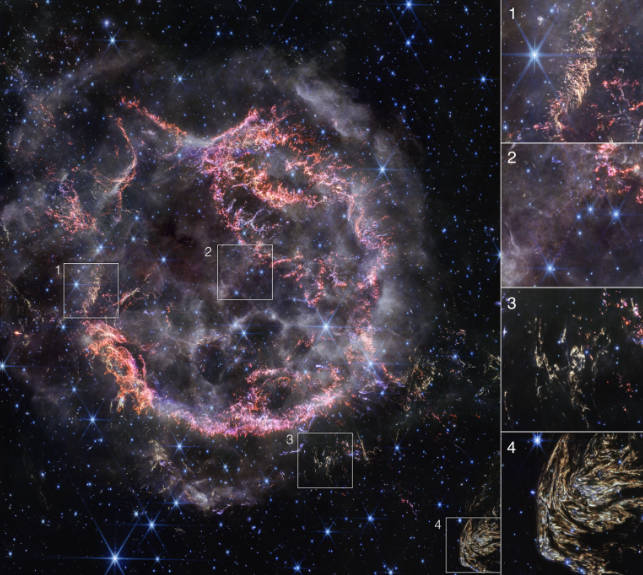NASA's James Webb Space Telescope has just captured a captivating view unfolding in space!
HD View of an Exploded Star
This high-definition view features the exploded star and supernova remnant Cassiopeia A (Cas A). The image was revealed as part of the first-ever White House Advent Calendar and celebration of the 2023 Holidays at the White House by First Lady Jill Biden and NASA on Sunday.

Contrary to the serene imagery of a silent night, Webb's Near-Infrared Camera (NIRCam) provides a radiant glimpse into the remnants of Cas A, showcasing intricate details of the expanding shell of material resulting from the star's explosive demise.
This view was captured at a previously unattainable resolution at these wavelengths and vividly portrays the aftermath of a stellar explosion. Cas A has been a subject of observation by various ground-based and space-based observatories over the years.
NASA's Chandra X-Ray Observatory, Hubble Space Telescope, and the now-retired Spitzer Space Telescope have contributed to assembling a multiwavelength portrait of the exploded star. Webb's razor-sharp view, as depicted in the NIRCam image, exposes bright orange and light pink clumps constituting the inner shell.
These colors represent gases like sulfur, oxygen, argon, and neon emanating from the exploded star, with embedded dust and molecules that will eventually contribute to the formation of new stars and planetary systems.
'Tiny Shards of Glass'
The high-resolution view provided by NIRCam allows astronomers to discern minute details, such as tiny knots of gas, which are less than 10 billion miles across, within the expansive Cas A, spanning 10 light-years or 60 trillion miles in its entirety.
According to Danny Milisavljevic of Purdue University, who leads the research team, this level of resolution unveils the intricate aftermath of the star's explosion, akin to "tiny shards of glass."
Comparing Webb's near-infrared view with the mid-infrared view, peculiar differences emerge. The NIRCam image, while seemingly less colorful, results from the wavelengths at which the material emits light.
The image depicts the inner shell's clumps in bright orange and light pink, showcasing the explosion's aftermath. The outer regions of the inner shell, appearing deep orange and red in the MIRI image, now resemble smoke from a campfire in the NIRCam image.
The white color from the blast wave indicates synchrotron radiation generated by charged particles spiraling around magnetic field lines. According to NASA, this radiation is visible across the electromagnetic spectrum, including the near-infrared.
Read Also : NASA's James Webb Space Telescope Finds Something Weird Inside Mysterious 'Brick' in Milky Way

Baby Cas A
While the enigmatic Green Monster, a loop of green light in the central cavity, is not visible in NIRCam, the near-infrared view reveals circular holes faintly outlined in white and purple emission.
Researchers believe this represents ionized gas due to the supernova debris sculpting the gas left behind by the star before its explosion. One captivating feature in the NIRCam image is the large, striated blob, Baby Cas A, positioned at the bottom right corner.
This phenomenon is a light echo, where light from the star's ancient explosion reaches and warms distant dust, causing it to glow as it cools down. Researchers are intrigued by the intricacy of the dust pattern and the apparent proximity of Baby Cas A to the main supernova.
According to NASA, the Cas A supernova remnant, located 11,000 light-years away in the constellation Cassiopeia, is estimated to have exploded around 340 years ago from our vantage point.

ⓒ 2025 TECHTIMES.com All rights reserved. Do not reproduce without permission.




